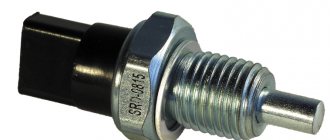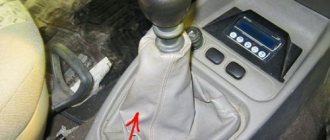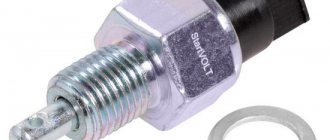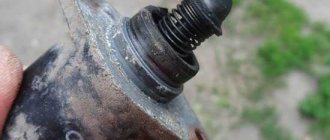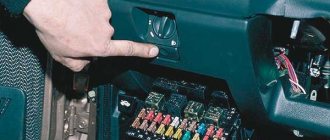The mileage of the car is 2500 km, and the check is already lighting up with alarming frequency. The pre-installed BC multitronic displays a message that error P0504 is a problem with the brake pedal sensor. I erase it so that it doesn’t become an eyesore, but nevertheless, the error pops up. What to do? How can I adjust/change this button? In the photo this bastard is indicated by a red arrow. As people write, you need to play with adjusting it, which is done with two nuts. The most common thing is that people adjust so that the sensor button barely touches the brake pedal pad. In general, let's give it a spin and see. My BC immediately starts yelling as soon as I start the car, saying there is a mistake. I'll go dig around this weekend.
I noticed that the error pops up more often when you stand on the brake with the selector “D” on. I think the problem is deeper than just adjusting the sensor.
Yesterday, April 14, 2014, I was at the dealer for maintenance. In particular, he voiced hemorrhoids with error P0504. The dealer cheerfully undertook to fix everything. But he didn’t fix it, he said that we need to order a brake sensor, they say it’s defective. I drove out of the gate and wasn’t even surprised when the CHECK light came on again. And this morning the car did not start from the remote control, the BRAKES light was displayed on the key fob, which was corrected by pressing the brake a couple of times, then the car simply did not move, became dull, twitched, but after hitting the brake pedal again, everything was corrected, but then again. In general, the morning did not go well. I freaked out, went to the store and bought this damn sensor.
Here he is, the bastard, in the photo. I went to the dealer, where they changed it for me in 25 minutes without charging a penny. On my part, the cost is 170 rubles for a purchase in a store. So far nothing lights up or jerks. I want to disassemble the removed sensor at home and see what in such a cheap and simple part for 170 rubles was ruining the life of a car worth 450,000 rubles! The truth is, I don’t know how to assemble it, the upper part is on three clips, which are very hard, I wouldn’t want to break it.
I will continue the epic with the sensor. Today, 04/24/2014, Jackie Chan’s new dachik lit up again - P0504. Yesterday I disassembled the old sensor.
What is immediately visible is that the small spring sitting on the rod is crooked. Contacts (nickels) of different heights. In pair 3-2, contact 2 rings in a dull tone, rang with a beeper, if on all the others it beeps loudly and loudly, then on the 2nd it is dull and quiet.
The crooked spring was replaced by another, equal in stiffness, as far as I could determine, and equal in length. I understand that when the brake pedal is released, the rod goes inward and presses the floating contact to the upper group; when you press the pedal, then to the lower one. The scheme couldn't be simpler. However, it doesn't work as it should! the spots were all set up, as if a small welding was working, on one spot there was a mark from the very edge, therefore the floating contact was pressed crookedly. As I understand it, it could have been welded, which sent a signal to the brain that the car was on the brakes.
Everything leads me to the fact that the sensor is made of bullshit! The lower spring is crooked, the terminals are made of poor steel, the spots are made of metal coated with something yellow, which can be removed by sanding with sandpaper. Small spring is crooked. The floating contact does not sit exactly on the patch; it has a slight play. All together will result in unstable work. I put everything back in place, didn’t touch anything, just polished the contacts, started ringing - don’t ring contact 3-2, even if it cracks. And so and so, it seemed to ring. Well, how does this happen? Basically crap. I decided to find a replacement for it, and found this:
Brake limit switch VAZ 2114
Handbrake light (LR) - an indicator on the dashboard in the form of an exclamation mark with curved lines on the sides (sometimes there is the inscription Brake).
Indicates that the car is on the parking brake (ST). Possible causes of the problem:
the harnesses have become frayed as a result of long-term use;
failure of the ST cable under the influence of external factors;
frequent emergency braking.
The optimal solution would be to replace the worn part.
What to do if the handbrake light does not light up?
Popular advice from experienced drivers is to look at the limit switch and its connector. Find the hidden stopper (the reference point is the end of the handle). Push it and pull it. Remove the casing and look under it for the lock.
Let's look at options for different brands.
On the VAZ 2114 (as well as on the VAZ 2107) the weak point is weak contact at the terminals (we are talking about the limit switch). It is also possible that the wire has come loose. Solution: disassemble the tunnel cover, assess the condition of the contents and “ring” it.
On LADA Granta it happens that the brake fluid float is “buggy”.
In GOLF 3, car owners are faced with a non-functioning indicator after replacing the rear brake elements (there is a risk of damaging the limit switch in the process).
Check the brake fluid level: unscrew the cap from the brake fluid reservoir, press the float. If the level of the working solution is insufficient, replenish it.
Advice from experienced car owners:
look at the fastener (for example, for reliability of fastening to the plate and for the presence of interfering foreign objects);
sometimes it’s enough to use WD and move the handle up/down;
tap the dashboard - this helps if there is poor contact.
Error P0504
This malfunction is associated with an incorrect signal from the brake pedal switches. Most often, the cause of such a failure is a malfunction of the brake pedal position sensor, lack of proper adjustment, or a broken spring that is installed in this device. Procedure for checking and troubleshooting:
- We remove the sensor;
- Move the rod lock to the right position using a screwdriver;
- We use a multimeter with an ohmmeter function;
- On Largus, Vesta and Xray cars, contacts 3-4 should be closed and have a resistance close to zero. Contacts 1-2 are open and their resistance should tend to infinity.
- When you press the rod on contacts 3-4, the circuit opens, and on contacts 1-2 it closes. If this is not the case, then the sensor must be replaced.
- On Priora, Kalina, Granta, Niva cars, contacts 1-4 should be closed, and 2-3 open. When you press the rod, the situation is the opposite.
- Before reinstalling the sensor, move the rod to the left position.
Sensor locations on video:
Adjusting the brake pedal position sensor:
Any driver can carry out this procedure at home without a trip to a service station. The part has two nuts in its design. One of them is on top, and the second is on the bottom. The upper nut adjusts the pressure of the rod. First you need to release the lower one, and then tighten the upper one, thereby changing the gap of the element. You need to ensure that the rod is fully pressed and not partially pressed. After this, start the car and let it run for about 10 minutes to check if the error appears.
Additional Tips
Before each trip, especially over long distances, you should check the functionality of all lighting equipment, including brake lights. In order to reduce the likelihood of breakdowns along the way, you need to periodically check the condition of the sockets and bases of the rear light bulbs, and periodically clean them of oxides and dirt.
In case a breakdown does occur, you should always have an additional set of light bulbs and 10 amp fuses in your car, as well as a multimeter to check them.
Causes of error P0504 Granta
An error regarding an incorrect signal from the brake pedal switches occurs in some cases solely due to an unadjusted limit switch. The fact is that after reflashing the electronic control unit M 74 and M 74.9.7, engineers made some adjustments to the engine control algorithm, which ultimately should have affected the reduction of harmful emissions. In practice, changing the firmware only strangled the engine and caused a bunch of problems with sensors and limit switches.
The Lada Granta has both a brake pedal position sensor, a limit switch and a brake light switch installed in one housing. The first reason for the appearance of error P0504 is incorrect adjustment of the position of the sensor housing.
How to adjust the Grant brake pedal sensor
The sensor is fixed to the bracket with two nuts screwed onto a plastic housing. The upper nut is responsible for the position of the sensor relative to the brake pedal. The nominal gap between the pedal platform and the heel of the sensor should be 2-3 mm when the pedal is fully released.
If there is no gap, the sensor may be triggered at the slightest touch of the pedal, which leads to error 0504 and activation of the Check Engine warning light. After simply adjusting the gap with two keys, we start the car and look for errors. P0504 will not reset immediately, but if the problem was an adjustment, the error code will disappear after 10-15 minutes of running the engine at idle speed. If this measure does not help, we check and look for the reason further.
Broken brake pedal sensor
One of the likely reasons for the appearance of this error on Grant is a malfunction or defect of the brake pedal end itself. The quality of AvtoVAZ components has always left much to be desired, and this happened this time too. Even domestic sensors, as a rule, are equipped with cheap Chinese springs and contacts. As a result, the springs break and the contacts simply burn out after 5-8 thousand mileage.
Brake pedal sensor Lada Granta / Kalina-2, Datsun (old model)
Brake pedal sensor (brake signal switch) Lada Granta / Kalina-2, Datsun (old model).
To connect the sensor, you may need a sensor connector.
Product characteristics
We recommend watching
Connector for connecting the brake pedal sensor 1118-3720010 old model for Lada Gran..
New items
Original factory trim for the left (driver) seat on the inside for Lada Vesta. The cladding will need to be replaced..
LED fog lights with low and high beam from the manufacturer Sal-Man with 7 lenses. The headlights are suitable for cars:..
LED rear bumper fog lamp for Lada Granta (liftback) and Vesta (all body types) cars with a pattern in...
LED rear bumper fog lamp for Lada Vesta cars (all body variants) with the inscription VESTA. Lantern mouth..
LED fog light in the rear bumper for Lada Granta (liftback) cars with the inscription GRANTA. The lantern is installed..
Reversing lamp GE / TUNGSRAM. Power: 16W Voltage: 12V Brightness, lm: 310 Base: W2.1×9.5d ..
Car lamp R10W 12V GE, used in the rear lights of Lada Granta (liftback and station wagon), Kalina-2, Datsun Mi-Do and others..
The turn signal lamp is orange, applicable for cars Lada Largus, Niva, Vesta, Xray, Granta, Kalina, Kalina-2, Priora, ..
Caliper repair kit for Lada Niva (4x4 Legend), Chevrolet Niva, Niva Travel. Includes: 21210-3501051-00 ring..
Camshaft plugs for the 16-valve K4M Lada Largus engine, set of 2 pieces. ..
This product belongs to a group of products that are manufactured (painted) individually for each customer. This item is shipped..
Rear bumper diffuser for Lada Granta FL sedan. The texture of the plastic is shagreen. The diffuser is installed using a double...
Original standard anti-roll bar with a diameter of 24mm for Lada Granta, Kalina-2 and Datsun cars, assembled...
A set of original front and rear plastic fender liners with sound insulation for the Lada Niva Travel car. The price is indicated..
A set of original front and rear plastic fender liners with sound insulation for the Lada Largus FL car (except Cross) (from March..
A set of original front and rear plastic fender liners with sound insulation for the Lada Largus Cross FL car (from March 2021.
A set of original front and rear plastic wheel arch liners for Lada Vesta sedan and SW (station wagon) models..
Set of rubber interior carpets with honeycomb-shaped cells for Lada Priora (any body). Avtodriver car mats -...
Instructions for replacing the brake controller
- Pump out the liquid.
- Place the vehicle on a support stand and remove the wheel.
- Use a wrench to unscrew the two wheel pins.
- Remove the brake drum.
- Then, using a screwdriver, pull out the hook of the upper tension spring and remove the part. Perform the same manipulation with the lower tension spring.
- Then remove the front pad and spacer bar, while disconnecting the pressure spring and lower the pad.
- Remove the shoe lever from the parking brake hole, straighten the cotter pin and remove it from the parking brake drive.
- Remove the washer and lever.
- Install a new block and assemble the part in the reverse order.
Rear disc brakes on Lada Kalina
Checking brake pad wear
We check the degree of wear of the brake pads of the front brake mechanisms in the following sequence.
1. Place the car on the inspection ditch.
2. Remove the front wheels.
3. When checking the pads of the left brake mechanism, turn the steering wheel completely to the left, and when checking the pads of the right brake mechanism, turn it to the right.
4. Through the inspection hole in the movable caliper bracket, we visually determine the thickness of the brake pads.
If the thickness of the lining of at least one pad is less than 1.5 mm, we change all the brake pads of the brake mechanisms of the right and left wheels.
When is pumping required and how to prepare for it
Bleeding the brakes is not always necessary - if the brake system is functioning properly, then bleeding is not necessary.
It is required only in the following three situations:
- When the pedal begins to “fail” (as was mentioned at the very beginning of the article).
- After replacing any component of the brake system.
- After replacing the fluid.
All these situations are caused by one single reason - air entering the system. So, if the pedal began to “fall” by itself, then, most likely, the brake tract was depressurized in some area, and air leaked inside.
When replacing parts, air also enters the brake system in large quantities and remains inside, causing its failure (the same applies to a complete replacement of the brake fluid).
Checking the brake fluid level
The brake fluid level is checked periodically: daily during vehicle operation, during each maintenance, after operations to pump the brake system hydraulic drive and replace the brake fluid, when a warning lamp lights up on the instrument panel, indicating an insufficient level of brake fluid in the master cylinder reservoir.
1. We prepare the car for work.
2. Use a rag to remove dirt from the master brake cylinder reservoir.
3. Visually check the brake fluid level in the reservoir. It should be between the MIN and MAX marks on the tank body.
4. Check the degree of wear of the brake pad linings of the front and rear brake mechanisms.
5. If the wear of the brake pads is within normal limits, and the fluid level in the reservoir is below the MIN mark, then disconnect the tip of the wiring harness from the emergency brake fluid level drop sensor, unscrew and remove the reservoir cap.
6. Add new brake fluid to the reservoir up to the MAX mark (when installing the reservoir cap, the sensor float will be immersed in the liquid and its level will increase).
7. Close the tank lid tightly.
8. Connect the wiring harness block to the sensor connector.
9. Check the operation of the emergency brake fluid level sensor: with the ignition on, press the rubber lining of the reservoir lid from above. If the sensor is working properly, the warning lamp on the instrument panel will light up.
When is clutch adjustment required?
VAZs use a dry type of clutch, that is, there is a basket consisting of two parts - driving and driven
Clutch adjustment of the VAZ 2114, and other vehicles, is carried out in cases where defects associated with the operation of this mechanism appear. Such malfunctions include:
- clutch pedal adjustment;
- clutch cable adjustment;
- pedal height adjustment;
- clutch adjustment.
In another case, the need to adjust the clutch drive may arise due to previous incorrect adjustment. It is possible to reduce or increase the working stroke of its pedal.
The photo shows the clutch of a VAZ 2114
As a result, malfunctions occur in the operation of the drive - the clutch begins to “slip” or “drive”, gear shifting becomes difficult, jerks appear when starting from a standstill, fuel consumption increases, etc.
Wiring and light bulbs are common factors in code 0504.
Again it is worth paying attention to the components.
If the owners of the Granta did not leave reviews, it would be incorrect to blame the functioning brake lamp for a malfunction. However, this point does occur. The active spiral of the 1-pin brake light bulb stretches over time, while the antennae that hold it close with the rest. In this situation, it makes sense to install new brake lamps, which can help correct error P0504. Possible causes of the Check Engine error and alert may be:
- burnt contacts on the limit switch;
- weak contact of the light bulb base;
- short circuit of the brake light power supply wiring.
These errors are easy to check. There is a voltage at the sensor supply wires of 0.12-0.15 V - which means you need to look for a short circuit or oxidation on the contact blocks/boards. Note that there should be no voltage on the supply wires.
What to do based on the cause of the breakdown
The procedure for restoring the VAZ 2114 reverse sensor will depend on the general picture of the malfunction:
- Oxidized wiring contacts must be thoroughly cleaned and then returned to their place. The negative terminal of the battery will need to be disconnected first.
- The loose sensor is screwed into place as tightly as possible.
- They test the wires, clean the problem parts or install new, serviceable elements instead of the problem ones - when there is no contact with the box.
- If there are problems connecting the plug to the block, check the contacts, clean them or change the wiring.
If a fuse blows, only replacing it will help.
Check the light bulbs themselves - they may be the reason for the lack of light if the wiring and contacts are intact. Faulty light bulbs are replaced.
Price issue
If the price of a VAZ 2114 reverse sensor varies between 100-300 rubles, and you can install it yourself, then the problem in the wiring or with the headlight board will not be so easy for you.
Before purchasing wiring components, clean the contacts and spray with WD-40, this should help. Because the purchased wires also need to be installed wisely, and this is electronics - a delicate matter - available to craftsmen in the service for a good fee.
As for the headlight circuit board, this is also a controversial issue, requiring investment both in the part itself and in the work of a professional who will take care of it. Burnt out light bulbs in a headlight are the cheapest consumables; one light bulb costs 20-50 rubles.
Source
Self-repair price
The cost of a new reverse sensor depends on the manufacturer. The average price of a part is around 300 rubles; you can find options three times cheaper. Please note that the less a spare part costs, the lower its quality and, accordingly, reliability and service life. It is advisable to place orders in trusted stores.
Replacement will also require contact cleaner such as WD40. Many additionally replace wiring if it is deformed, kinked, or otherwise damaged. We do not recommend working with wires without proper experience; it would be better to contact a specialist.
Sensor bulbs cost up to 50 rubles apiece. It's easy to unscrew the old ones and screw in the new ones yourself.
Repair methods
To repair the reverse signal, you can proceed in two ways. They differ in the way the sensor is accessed.
- Drive the car onto a lift or pit.
- Do the work by climbing under the car.
If you have already encountered a similar problem, then you will probably agree that replacing the DZH is best done using a pit or overpass. This makes access to the sensor as comfortable as possible, plus you minimize the risk of being splashed with oil from the gearbox.
Replacing the DZH is not the cleanest job
Of course, there is another cleanest way - sending the car to a car repair shop. But then you will have to pay not only for the sensor, but also for the services of the specialists. And this is another 2-3 times the cost of the sensor. The choice is yours anyway.
Self-replacement
It’s not difficult to get to and replace a failed DZH on your own. Follow the instructions, do not break the sequence of operations, and then the process will not take you much time and effort.
- Place the car on a pit or overpass. Be sure to apply the handbrake and place the transmission in first gear. This will help prevent your car from accidentally rolling away.
- Remove the protection from the contacts of your sensor, disconnect the contacts.
- Prepare a container into which the oil will be drained when unscrewing the DZH.
- When the container is ready, remove the sensor. In some cases, it may not be unscrewed by hand. In such a situation, use a 22 mm socket.
- Very rarely even the key cannot help, since the sensor becomes stuck to its location. Here you will have to arm yourself with a hammer and chisel and try to remove it as carefully as possible.
- Take out the failed device and insert a new one in its place.
- If oil gets on the gearbox housing, remove it with dry rags. There is no need for extra dirt. Plus, it can lead to a decrease in the efficiency of the device.
- Return all contacts to their places, put the protection back on.
- If a decent amount of lubricating fluid has spilled out of the box, be sure to top it up. Just use fresh ones. By the way, this is one of the reasons to completely change the oil in the gearbox if it has been there for more than the first season.
- The decision to change the oil will simplify the task when removing the sensor. If the liquid is drained in advance, it will not flow in different directions when the sensor is unscrewed. The work will be cleaner, plus you will kill two birds with one stone - replace the sensor and gearbox oil.
